- Country Areas
- Methods and indices
- Explore oral health
- About CAPP
-
- Bank of Ideas
- Nepal - Basic Oral Health Training Programme for the Health Workers of Ramechhap District
- Nepal - Manang Dental Camp Report
- Nepal - School based oral health project in remote Timal Besi
- Nepal - Training Female Community Health Volunteers in Oral Health Education
- United Kingdom - Fissure Sealant Programme for Schoolchildren in Wales
- United Kingdom - Boost Better Breaks - A School based Public Health Programme in Northern Ireland
- United Kingdom - Training programme for nursing staff on oral health care of elderly residents of nursing homes in Scotland
- United Kingdom - An Oral Cancer Awareness Campaign Programme, Scotland
- United Kingdom - Designed to Smile - Promoting Better Oral Health and Delivering Fluoride Supplementation to Children in Wales
- United Kingdom - Childsmile – the national child oral health improvement programme for Scotland
- Sweden - A school-based fluoride mouth rinsing programme
- Kenya - The Eric Dental Clinic
- Madagascar - The Vezo Hospital
- Nigeria - A School based oral health education programme for Children
- Seychelles - Dental Public Health Programmes
- South Africa - Hammanskraal Project
- South Africa - Phelophepa Healthcare Train
- Afghanistan - Dental Relief Project, Kabul
- Australia - Water fluoridation in remote Aboriginal communities
- Australia - An Aboriginal health and a Government school dental service in South Australia
- Austria - Oral Health Promotion Programme for preschool children, Vorarlberg
- Antigua and Barbuda - School based Fluoride rinse programme, 1989-1998
- Brunei Darussalam - Mission Report 1998 on training course in oral health survey method
- Cambodia - Mobile dental care for schoolchildren in Sihanoukville
- Cambodia - Outreach programme for improving oral health of under privileged children in Sihanoukville
- Cambodia - Oral Health promotion in schools in Kampong Cham
- Namibia - The "Smiling Schools" project
- South Africa - An Atraumatic Restorative Treatment (ART) Project: Activity Report
- South Africa - An Atraumatic Restorative Treatment (ART) in a Mobile Dental Clinic, Johannesburg
- Tanzania, United Republic of - The Outreach programme in primary schools around the Dar es Salaam area
- Argentina - An Oral Health Preventive Programme for School Children
- Brazil - Atraumatic Restorative Treatment for a disadvantaged Brazilian Community
- Chile - A school based oral health programme in Cabildo (2008)
- Chile - Fluoridated milk programme for rural primary school children
- Chile - Fluoridated Powdered Milk Programme
- El Salvador - Community-based programme for prevention of dental caries among children
- Honduras - Oral Health Education and Care for a resource poor Honduran community
- Honduras - Oral Health and Care in Delicias
- United States of America - Oral Health Programme for Navajo Indians in Pine Hill, New Mexico
- United States of America - Oral health Education and Sealant programme for West Philadelphian Schoolchildren
- Kuwait - A school based oral health programme during 1986-1997
- Kuwait - Community Based Schoolchildren's Oral Health Programmes 1985 -1998
- Kuwait - School Oral Health Programme (1982-2011)
- Lebanon - Final Report, a baseline survey of oral health situation and fluoride levels in drinking water (2000)
- Saudi Arabia - An ongoing oral health promotion programme
- Saudi Arabia - The Celebration of the 20th anniversary of the accession to the throne of King Fahd Ibn Abdul-Aziz
- Saudi Arabia - Oral Health Education Programme for schoolchildren in the Holy City of Mecca
- Sudan - An Oral Health Promotion through live art in Sudan
- Syrian Arab Republic - An ongoing oral health preventive programme
- United Arab Emirates - Assignment Report 1995-96 with recommendations to build a comprehensive oral health care
- United Arab Emirates - Dental Public Health Programs implemented by Dental Services Department, Dubai
- United Arab Emirates - MY SMILE” - tooth brushing program for school children in Dubai, UAE.
- Bulgaria - A community based milk fluoridation programme 1988-1993
- Bulgaria - The clinical effect of milk fluoridation for school children
- Croatia - Healthy Smile Day
- France - A School Based Oral Health Education Programme
- Germany - Third German Oral Health Study - 1997, Summary
- Germany - An Oral health programme for children attending kindergartens in two Counties in Northern Hesse
- Romania - Fluoride mouth rinsing Programme in Schools in Constanta and Iasi connties (2001-2010)
- Russian Federation - Programme focusing educating parents of infants on the prevention of caries, Moscow
- Sweden - An oral health programme for preschool children in a multicultural city area
- Sweden - The Oral Health Lift - An Oral Health Promotion Programme for the Homeless and other socially vulnerable people in Malmö
- Sweden - School based fluoride varnish application programme
- Turkey - Ongoing Atraumatic Restorative Treatment (ART) Programme in some rural areas
- Turkey - A reliable and practical dental preventive/education program model for Turkey - "brushes in the bags, teeth on the healthy-way"
- India - Training oral health workers to provide basic dental care in Ladakh
- Indonesia - Affordable toothpaste project (WHO) in West Kalimantan
- Sri Lanka - School based public health programme in Jaffna
- Sri Lanka - ART Training Programme for School Dental Therapists, Jaffna
- Sri Lanka - An oral cancer screening project in tea estates
- Sri Lanka - Oral Health Camp in rural area
- Sri Lanka - Dental public Health Programmes conducted by the Population Oral Health Unit (Community Dental Unit), Dental Institute, Colombo
- Thailand - The Royal Mobile Dental Unit project
- Thailand - School based oral health programme for children in Southern Thailand
- China - A campaign on "Love Teeth Day" celebrated nation-wide each year
- China - Milk fluoridation project (WHO) in Beijing
- China - An oral health education programme in Wuhan City
- China - An oral health education and supervised tooth brushing programme in kindergartens
- Japan - A school-based fluoride mouth rinse programme for preschool children
- Japan - Visual Support Material for Children with Autism in order to Master Toothbrushing Skills
- Viet Nam - School-based Oral Health Programme
- Viet Nam - Mission report 1999 with recommendation for oral health training
- Viet Nam - Oral health program in South Central Vietnam
- Vanatu - Mission Report on Oral Health
- Tonga - Mission Report 1997 reviewing the oral health programme
- Tokelau - Mission Report 1999 on recommendation to improve oral health
- Philippines - Mission Report 1998 on planning and implementing a national oral health survey
- Philippines - The Essential Health Care Package- “Fit for School” programme
- Mongolia - Mission Report 1999 with recommendations to improve oral health (1)
- Malaysia - reports from Oral Health Division
- Lao PDR - Caries prevalence and some caries related factors for 12-year-old children from Vientiane and Luang Prabang provinces
- Lao PDR - Estimating the fluoride concentration in the drinking waters
- Korea, Republic of - Community based caries prevention programme in a suburban area
- Sri Lanka - An ongoing school-based ART Programme
- Vanuatu - Gudfala Tut Skul Program (Healthy Tooth School Program)
- Estonia - Suukool, a mouth school
- Palestine - Integrating the WHO Health Promoting School Concept into National School Oral Health
Oral health promotion
Oral health promotion
Worldwide, 60–90% of school children and nearly 100% of adults have dental cavities. Severe periodontal (gum) disease, which may result in tooth loss, is found in 15–20% of middle-aged (35-44 years) adults.
The burden of oral diseases and other chronic diseases can be decreased simultaneously by addressing common risk factors. Risk factors for oral diseases include an unhealthy diet, tobacco use, harmful alcohol use and poor oral hygiene, and social determinants.
Bank of ideas
Numerous oral health promotion (education and intervention) programs have been conducted worldwide and many are still ongoing. The aim of these pages is to present different types of oral health programs that actually have been implemented, and that are suitable for a particular country, area or region. The Bank of Ideas will hopefully inspire health planners around the world to develop programs that would fulfill their need.
Fluoride
Dental cavities can be prevented by maintaining a constant low level of fluoride in the oral cavity. Fluoride can be obtained from fluoridated drinking water, salt, milk and toothpaste, as well as from professionally-applied fluoride or mouth rinse. Long-term exposure to an optimal level of fluoride results in fewer dental cavities in both children and adults.
Read more
”Fluoride and Oral Health” 2016. Community Dental Health.
Use of Professionally Administered Topical Fluorides in Asia
Effective Use of Self-care Fluoride Administration in Asia
Toward Effective Use of Fluroride in Asia
Atraumatic Restorative Treatment (ART)
Introduction
Although dental caries has substantially decreased in the industrialized countries, it remains to be a widespread problem all over the world. Most of the carious teeth in the developing countries tend to go untreated to such an extent that the only treatment option available is extraction.
Atraumatic Restorative Treatment (ART) approach was developed to suit the needs of the developing countries. ART includes both prevention and treatment of dental caries. This procedure is based on excavating and removing caries using hand instruments only and restoring the tooth with an adhesive filling material such as glassionomer.
Unlike the conventional methods ART is non-threatening, not painful therefore does not need anaesthesia, does not use expensive electrically driven equipment and can be provided at low cost. This technique is simple enough to train non dental personnel or primary health care workers. All one needs are a flat surface for the patient to lie, a stool for the operator and the necessary instruments and materials for ART which can easily be carried in a small bag. ART therefore is suited for people residing in remote areas and for field practise and can be carried out in schools, village halls or in health centers with minimum equipment and resources. ART is a perfect alternative treatment approach for dental caries in the developing countries where as mentioned earlier quite often carious teeth go untreated and eventually have to be extracted.
Community Field Studies with ART
The ART approach was pioneered in Tanzania in the mid 1980s which was then followed by several community field trials conducted in Thailand, Zimbabwe and Pakistan in 1991, 1993 and 1995 respectively. Results of the studies in Thailand and Zimbabwe have shown that 71% and 85% respectively of the ART restorations remained in the teeth after 3 years.
Glass-Ionomer as a Restorative Material in ART
Glass-Ionomers are very useful restorative materials. They are available as a powder and liquid that has to be mixed together. Since they chemically (not mechanically) bind to the teeth, the need to cut sound tooth tissue to prepare the cavity is reduced. These materials continue to release fluoride after setting which has the added advantage of arresting and preventing caries around the restorations. Glass-ionomers are harmless to dentine and pulp tissues. However compared with other materials glass-ionomers are not strong enough and are currently being improved by the manufacturers.
Instruments and Materials essential for ART
Only hand instruments are needed to perform ART. These are - mouth mirrors, explorers, pair of tweezers, spoon excavators, hatchets or hoes and carvers. A mixing-pad and spatula are also necessary to mix the filling material. Only a few other materials are needed- cotton wool rolls and pellets, petroleum jelly to protect the setting glass-ionomer filling, plastic strips to shape the restorations and wedges to hold the plastic strips to the teeth.
Future Applications of ART
As ART is based on modern concepts of cavity preparation where minimal intervention and invasion is emphasised, this approach is applicable also in the industrialized countries for special groups such as the physically and mentally handicapped and the elderly. ART is a friendly procedure where no electric drills or anaesthetic injections are necessary that it can be used for children and fearful adults.
Indications and Contra-Indications for ART
In general ART is carried out only in the small cavities (involving dentine) and in those that are accessible to hand instruments.
ART is not used when:
There is an abscess (swelling) near the carious tooth.
The pulp of the tooth is exposed.
Carious cavity not reachable with hand instruments.
Conclusions
- ART is NOT a compromise but a perfect alternative treatment approach for developing countries and special groups in the industrialized world.
- ART is a biological approach which requires minimal cavity preparation that conserves sound tooth tissues and causes less trauma to teeth.
- As ART is painless the need for local anaesthetics are reduced and so is the psychological trauma to patients.
- Simplifies infection control as hand instruments can easily be cleaned and sterilized.
- No electrically driven and expensive dental equipment needed which enables ART to be practised in remote areas and in the field.
- ART approach is very cost effective.
- Since it is a friendly procedure, there are great potentials for its use among children, fearful adults, physically and mentally handicapped and the elderly.
- It makes restorative care more accessible for all population groups.
References
1. Atraumatic Restorative Treatment Approach to Control Dental Caries- Manual, WHO collaborating Centre for Oral Health Services Research, Groningen 1997.
2. Frencken JE et al , Atraumatic Restorative Treatment (ART): Rationale, Technique and Development , J Pub Health Dent, 1996, Special Issue, 56, 135-140
Dr Jo Frencken serves as a Manager of WHO Global Project on ART. His e-mail address is: j.frencken@dent.umcn.nl
3. Barmes DE Forward, J Pub Health Dent, 1996, Special Issue, 56, 131.
ART manual
The following set of pictures are from an ART Manual prepared by Drs Jo Frencken, Prathip Phantumvanit, Taco Pilot, Yupin Songpaisan and Evert van Amerongen and from Dr Yupin Songpaisan, Thailand.
Recommended work posture and position for the operator.
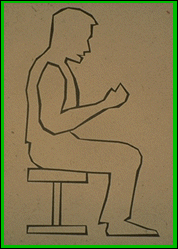
Recommended position for the operator and assistant. The patient lies on a flat surface.
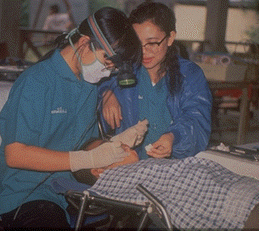
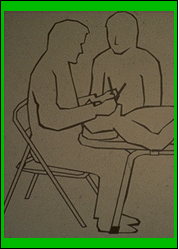
Hand instruments needed for ART are:
mouth mirror, explorer, a pair of tweezers, spoon excavator, hatchet or hoe and carver.

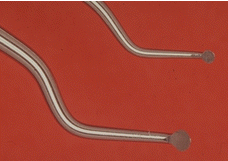
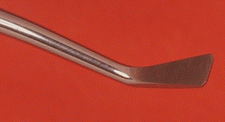
The area around the carious tooth to be treated is kept dry by placing cotton rolls. Then the cavity entrance is widened by using the hatchet or hoe. Now with the excavator caries is removed.

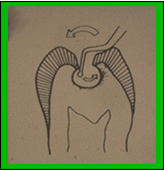
When all caries has been removed and the cavity cleaned and dried a dentine conditioner is applied on the cavity to improve the bonding of the filling material to the tooth.
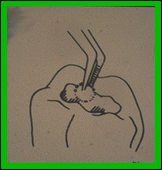

The glass-ionomer filling material consists of powder and liquid which is mixed on a glass slab or a mixing pad. Mixing is completed in 20 - 30 seconds.
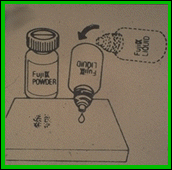
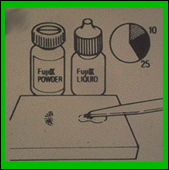
The mixture is inserted to the cavity with the flat end of the carver. The cavity is over filled to include remaining pits and fissures.


Rub some petrolium jelly on the gloved index finger and the filling material is pressed firmly with the finger on the tooth.

The excess material is being removed with a carver.



The patient is not allowed to eat for at least 1 hour. Note no anaesthesia is used and no dental drills are needed during the whole procedure.
Manuals:
Manual for the Atraumatic Restaurative Treatment (pdf)
How to carry out Atraumatic Restorative Treatment (ART) on decayed teeth - A Training Manual for Public Health Workers:
English (pdf)
Nepali (pdf)
Sinhalese (pdf)
Tamil (pdf)
Farsi (pdf)
Hindi (pdf)
Vietnamese (pdf)
Above Manual is recommended to Health Workers who have been trained by Dentists to perform ART and no way should be attempted without proper training and supervision.
